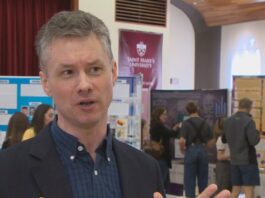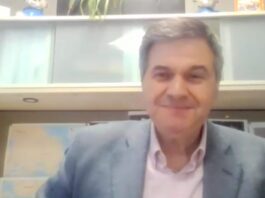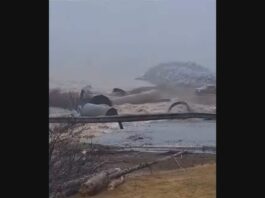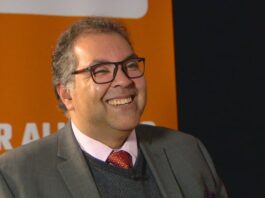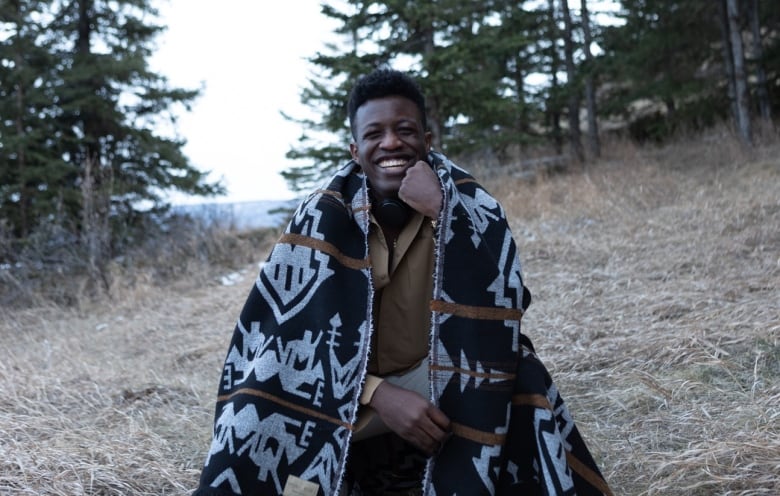
Our planet is changing. So is our journalism. This weekly newsletter is part of a CBC News initiative entitled “Our Changing Planet” to show and explain the effects of climate change. Keep up with the latest news on our Climate and Environment page.
Sign up here to get this newsletter in your inbox every Thursday.
This week:
- How to bring Black and Indigenous voices into the climate discussion
- U.S. heat pump sales are on the rise
- Ukraine wants to make Russia pay for environmental toll of war
How to bring Black and Indigenous voices into the climate discussion

Chúk Odenigbo is an environmental powerhouse. The 30-year-old is a founding director of Future Ancestors Services, a Black- and Indigenous-owned organization based in Calgary that provides training and research on climate and environmental justice. Odenigbo is also finishing his PhD in medical geography, which looks at the ways location affects human health. And he’s the co-founder of The Poison and the Apple, a non-profit that uses artistic projects to challenge people’s perceptions of nature.
Odenigbo spoke to Nicole Mortillaro about how Black and Indigenous communities interact with nature and the importance of amplifying their voices in any discussion of climate change.
Q: Black and Indigenous people are often the ones most affected by climate change, and yet they’re not necessarily at the table in negotiations for solutions. How do we change that?
A: We live in the most multicultural country in the world, we have the entire world within our borders. So that gives us access to a plethora of knowledge. But the issue that we tend to have is, when we invite people to the table to have discussions, it’s in a very Western framework. We have a one-hour meeting where we’re going to discuss X, Y, Z. But a lot of cultures don’t work that way. There are a lot of Indigenous cultures that need to meet and spend weeks building relationships and having meals together without talking about business, and then slowly bring up business here and there. And the same with Black communities. There are some Black communities where it’s appropriate to just speak to Black leaders, and other Black communities where you want to invite a sort of wider array of community opinions.
Q: There is distrust within racialized communities because of years of discrimination and being left out. What’s the solution?
A: In all honesty, it takes time, it takes openness, it takes vulnerability and it takes a willingness to change. And I think this is where the difficulty lies for a lot of organizations. And so you have to make an active effort to build relationships, direct relationships with communities, so communities can see you as a space that they can come to, and feel a sense of security and a sense of safety and welcome. And that takes time, that takes energy, that takes you showing up for powwows, it takes you showing up for community barbecues, it takes you … going into different communities.
Q: It has been well documented that people in low-income areas or Black communities within a city have fewer green spaces. What do you think is needed to change that?
A: There are many factors at work. There was an organization that went into a largely Black community in Toronto, and they started planting trees as a way of providing these green spaces and trying to sort of force the equilibrium of green space. And the residents ended up suffering for that, because with the increased green space came an increase in property value, which led to an increase in property taxes that are increasing rents. And so all these systems at work reveal the capitalistic system, such that if you are poor, nature is a tool of harm, because you’ll be then picking [between] green space or being able to afford rent.
Q: In an interview with the Nature Conservancy of Canada, you talked about camping and how Black communities often don’t connect with nature. Could you elaborate on that?
A: Intergenerational trauma is a very strong thing that’s hard to sort of get over. As Black people, oftentimes, when people are being racist towards us, it is to deny our humanity. And we often see, like, with Michelle Obama or, like, even with those Black British football players who lost the [2020 Euro Cup final], people were [saying things] like “monkey,” or using monkey emojis or comparing them to gorillas. Oftentimes, as a reaction to that, [Black people] tend to be highly urban, as a way of demonstrating that we are civilized. And so to go into nature is to almost quote-unquote prove the white people right: that we are animals. And so there is this intense resistance, because we don’t want to look silly, we don’t want to look stupid.
But it is also nature being weaponized against us. If you look at Africville [a predominantly Black community in Nova Scotia], it was completely demolished. So you’ve got all this nature being used literally as a tool of harm, as a tool of oppression against Black people. We need to see more Black faces in the outdoors. We need to be more visible outdoors.
Reader feedback
Doug Bennet:
“The article on the lack of data regarding climate change targets struck a chord. We are in the middle of converting from a natural gas furnace and hot-water system to electric heat pumps, with solar panels on the roof to offset higher electricity bills. In the course of this project, we have been trying to calculate our own household car’bon footprint (and how it might change over time). The exercise has been frustrating because results from different online calculators vary considerably, and most are based on underlying U.S. or U.K. energy assumptions.
“It would be helpful to have a solid Canadian-based ‘go-to’ household carbon footprint calculator, with built-in formulas that reflect, for example, the widely different sources of electricity generation in each province. No calculator will be perfect as there are so many variables. But one that can be tested and defended, with a simple user interface, would greatly assist households such as ours, trying to do the right thing.”
Éloïse Edom:
“As a modeller and model user myself working in the energy sector, I particularly agree with NZAB’s recommendation on the need for more modelling to support informed decisions for pathways to carbon neutrality. Last year, in May 2022, after two years of engagement and consultation across Canada, under the name of the Energy Modelling Initiative, a new pan-Canadian organization was created to support our energy modelling capacity: the Energy Modelling Hub (EMH). This organization aims to provide and maintain full access to robust, open-access modelling tools and resources. It brings together a broad community of energy modellers and policy-makers to support them in the development of a decarbonized energy system.
“I think this is a good example of work being done in the right direction to achieve our climate goals.”
Old issues of What on Earth? are right here.
CBC News has a dedicated climate page, which can be found here.
Also, check out our radio show and podcast. Ice rinks can be a climate casualty. This week, we’ll bring you some solutions, and the story of a drag skating performance that was disrupted by warming weather. What On Earth airs on Sundays at 11 a.m. ET, 11:30 a.m. in Newfoundland and Labrador. Subscribe on your favourite podcast app or hear it on demand at CBC Listen.
The Big Picture: Heat pump sales on the rise
Sales of heat pumps — described by the International Energy Agency as a “critical technology for heat decarbonization” — surpassed sales of gas furnaces in the U.S. in 2022, according to statistics from the Air-Conditioning, Heating and Refrigeration Institute. That’s partly due to government incentives to cut carbon emissions and partly due to technology improvements to their performance in cold weather, reports Canary Media.
While many parts of the U.S. have a relatively mild climate, heat pump sales have also been soaring in colder states like Alaska and Maine. They’re expected to keep climbing, especially after the U.S. government announced new incentives last fall, under the Inflation Reduction Act, for both heat pump installations in buildings and heat pump manufacturers.
Heat pumps have taken off even more quickly in Europe, partly due to concerns over energy security in the run-up to the war in Ukraine. There, sales grew 35 per cent in 2021 relative to 2020, compared with 15 per cent in the U.S. over the same period, the IEA reports.
— Emily Chung

Hot and bothered: Provocative ideas from around the web
Ukraine wants to make Russia pay for environmental toll of war

Missiles and mortars kill and maim people, but Russia’s year-long war in Ukraine is also poisoning the air, ground and sea, says Ukraine’s minister of environmental protection, who is building a case that Russia should pay for its ecological “crimes.”
“We’ve lost some parts of our nature forever,” Ruslan Strilets said in an interview from the capital, Kyiv, referring to things like contaminated groundwater and burnt forests. Ukraine estimates the total environmental damage so far is more than $48 billion US.
From the first weeks of the war in early 2022, inspection teams across Ukraine have been sampling, photographing and recording water and soil contamination and measuring air pollution.
In June, for example, Russian missiles tore into a shopping mall in Kremenchuk, killing 20 people. According to the State Environmental Inspectorate, the inferno and billowing black smoke also spewed 2,200 tonnes of pollutants into the air, including ammonia, benzopyrene and sulphur trioxide.
Air pollution has increased by three to four times since the war began, even with industrial production at only about 30 per cent of pre-war output, says the environment minister.
“We can quickly rebuild a bridge or a house, but it will take decades to renew the nature that they’ve destroyed,” said Olena Kryvoruchkina, a Ukrainian MP and chief co-ordinator of the Operational Headquarters, which is collecting data and evidence of environmental ruin. But, she added, “we will try.”
Ukraine hasn’t worked out the mechanics, but it is mounting a case for ecological damage from the war to be a sizable part of any future compensation. The huge challenge will be to prove alleged crimes in any international court and force Russia to pay.
An estimated 15 per cent of Ukraine’s agricultural land is littered with mines and other unexploded ordnances, particularly in the eastern and southern parts of the country. In January, Strilets, the environmental protection minister, visited one of Ukraine’s national parks, the Holy Mountains in Donetsk region.
“I was shocked,” he said. “All of the park’s infrastructure is destroyed, more than 60 per cent of trees were burned.”
A few hours after his visit, a park employee was severely injured when he stepped on a mine.
“Russia must be held responsible,” Strilets said.
At the COP27 climate change conference in Sharm el-Sheikh, Egypt, in November, Ukrainian President Volodymyr Zelenskyy said the war had destroyed five million acres (about two million hectares) of forest in the first six months.
“There can be no effective climate policy without peace on Earth,” he said.
Doug Weir, research and policy director at the U.K.-based Conflict and Environment Observatory, says that “historically, we somehow separate out environmental damage from humanitarian consequences, when we all need to breathe, we all need to drink, we all need to eat. So, environmental damage and conflict is a humanitarian issue. It needs to be perceived as such.”
The Conflict and Environment Observatory is developing its own database on the war in Ukraine, with more than 700 cases logged so far, one of a number of international organizations collecting evidence.
Currently, there is no formal mechanism to pursue or prosecute environmental crimes, but there is precedent for compensation. After the 1991 Gulf War, the United Nations Security Council set up a Compensation Commission that bound Iraq to pay reparations for damage in Kuwait, including environmental damage.
Iraq ended up paying $52.4 billion US over three decades in compensation to more than 1.5 million claimants. (The Compensation Commission announced that the final payment to Kuwait was on Jan. 13, 2022.)
Russia’s role on the UN Security Council would complicate such a mechanism in this conflict, but there may be other routes, Weir says. The UN General Assembly passed a resolution in November recommending an international registry of damages to co-ordinate evidence.
The wider question, Weir says, is where the money for reparations would come from. “Would Western countries freeze Russian assets and use those to help pay reparations? Environmental remediation is expensive, it’s complex and it takes years.”
Quantifying the damage in economic terms is also complicated. Mark Zheleznyak, known for his work assessing the cost of the 1986 nuclear disaster in Chornobyl, Ukraine, has been enlisted by the country’s State Environmental Inspectorate to help establish the methodology.
“Our work is for the future,” Zheleznyak said. But he insists all the ongoing work will help Ukraine’s remediation plans, and could be “a blueprint for wartime damage and recovery assessment in other parts of the world affected by military conflicts.”
— Susan Ormiston
Stay in touch!
Are there issues you’d like us to cover? Questions you want answered? Do you just want to share a kind word? We’d love to hear from you. Email us at whatonearth@cbc.ca.
Sign up here to get What on Earth? in your inbox every Thursday.
Editor: Andre Mayer | Logo design: Sködt McNalty









